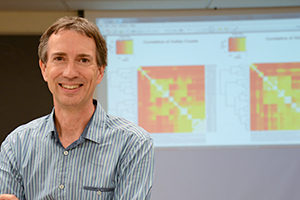
You’ve probably never heard of polycythemia vera, a rare cancer that pushes bone marrow into red blood cell production overdrive, upping the risk of blood clots and even leukemia.
While there is no cure for the disease, Michael Ochs, TCNJ associate professor of mathematics and statistics, and a colleague of his at Johns Hopkins, are a step closer to identifying patients who stand the best chance of benefitting from treatment.
“The treatment is very unfriendly—typically Interferon—and if you have the mild form of the disease, you don’t want to treat it so aggressively,” says Ochs.
Ochs, who worked at Hopkins before coming to TCNJ in 2013, helped to analyze a database of tissue samples that Jerry Spivak, the director of Hopkins’ Center for Chronic Myeloproliferative Disorders, had collected from over 600 patients with polycythemia vera.
It sounds a bit complicated, but for Ochs the task—and his research—boils down to estimating the probability of certain molecular changes occurring in cancer.
After controlling for differences in the disease connected to gender, Ochs and Spivak split the group into two: those they knew had the more aggressive form of polycythemia vera and those with the milder—or “indolent”—form.
The men ultimately identified six pairs of genes as a biomarker for the more aggressive form of the disease. The team’s findings were published in The New England Journal of Medicine on August 28.
Ochs has had a long and varied career, earning his bachelor’s at Haverford College in chemistry, a master’s in Celtic languages and literature at Harvard, and his Ph.D. from Brandeis in physics. He worked for a large defense contractor for a year, delved into solar energy, and spent two years in a lab studying simian AIDS.
Admittedly, he says, “It’s been a meander.”
“I’d like to think that what I do is what a scholar has always done,” says Ochs. “What I want to work on is what’s interesting, or what’s an interesting problem. It’s something we’re losing a bit in academia. I think it’s becoming harder and harder not to be a narrow specialist.”
Looking ahead, Spivak and Ochs have submitted a grant request to the Leukemia and Lymphoma Society to continue their research on the biomarker. “Can we start to understand the biology that drives the biomarker?” asks Ochs. “If you want a new treatment option for the aggressive form, we need to understand that.”
—Renée Olson, with reporting by Mary Jo Patterson
